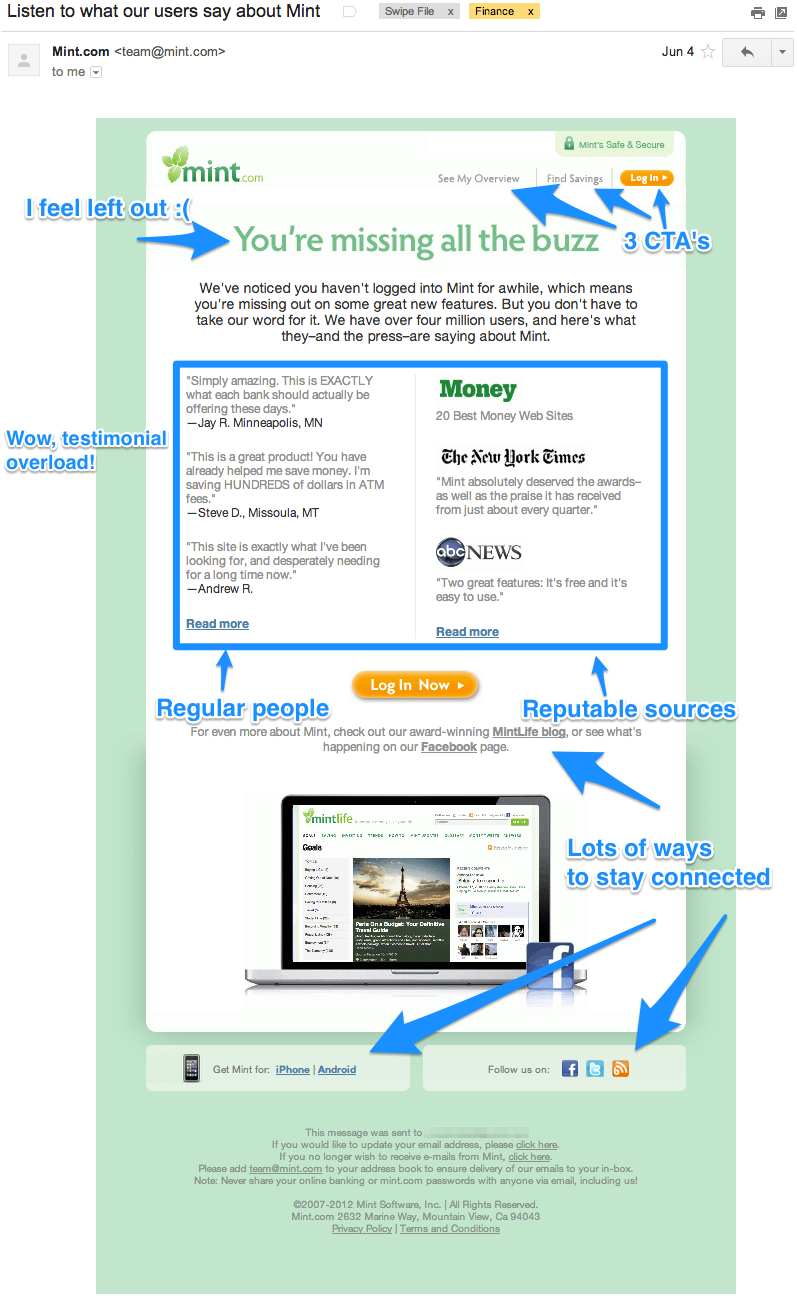How to Use Retention Emails to Make Money
-
UncategorizedUpdatedPosted:
On this page
Image via LeraBlog
Retention emails are the lowest-hanging fruit of the customer lifecycle.
It’s hard to increase your lead velocity rate and optimize your conversion to bring on new customers. Inactive users have already gone through that process and you’ve already invested time and money in them. They see value in your product and, at some point, were ready to become a customer.
Turning inactive users into active users is one of the easiest ways to generate revenue.
As our CEO Chris Hexton wrote on the CrazyEgg blog, retention equals revenue and email is the best way to do it.
Even if you’re acquiring the right sort of customers and activating them rapidly it’s super important to continue to monitor customers that go inactive and to prompt them to come back and use your software or purchase again. To maximize retention, spend a lot of time ensuring your customers don’t leave.
We took a look at five retention emails to see what keeps users engaged and what makes them forget about you. Check them out here, along with our five tips for creating killer retention emails below.
1. RunKeeper
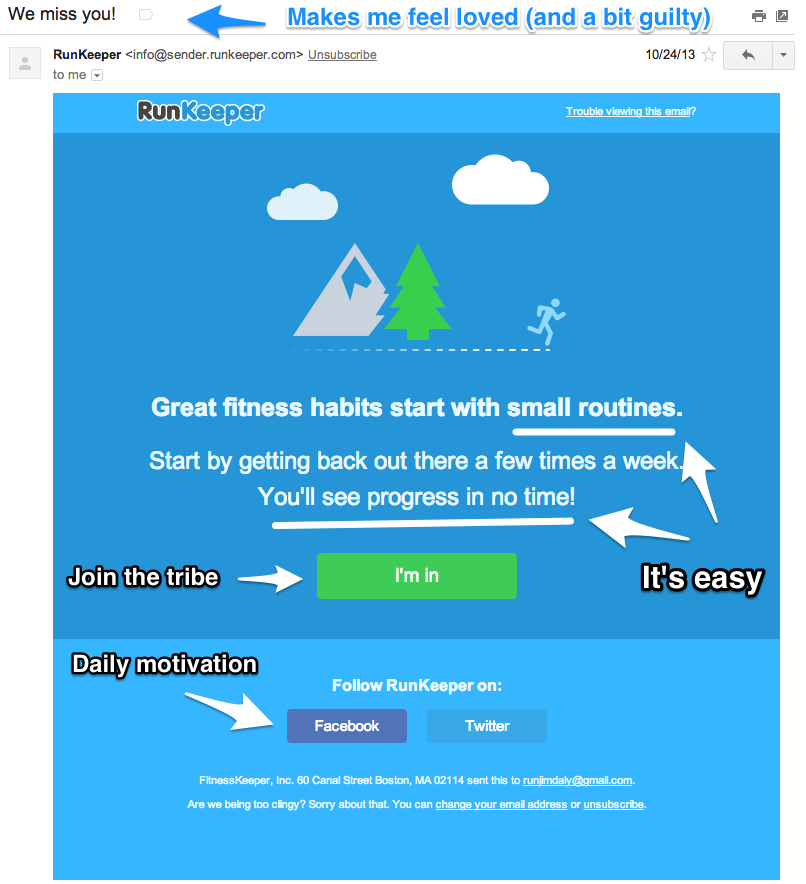
There’s a reason that fitness apps have become so popular. They do two things really well:
- Help people set goals, track progress and become healthier
- Make us feel guilty when we don’t exercise 😉
There is a lot of emotion tied to self-confidence and body image. When RunKeeper emails their users to reactivate them, they are asking for so much more than logging data in their app.
RunKeeper faces an interesting challenge. If their users don’t go out running on a regular basis, they have no reason to use the app. In order to keep user engagement high, RunKeeper actually has to focus on motivating people to exercise.
It’s an enviable position in some ways. People know they should be exercising and they know that using RunKeeper can help them lose weight and run faster. Both parties agree that app usage is a good thing. Instead of begging users to login and use their app, RunKeeper simply reminds users that getting back into an exercise routine is a good idea.
Why This Email Rocks
- The subject line “We miss you!” – strikes just the right tone. It makes me feel like I am part of a community. It also makes me feel a bit guilty for not contributing to the community recently. Whichever emotion it elicits for you, it gets the email opened.
-
There isn’t much copy in this email – just 24 words before the
button – but RunKeeper is able to get me excited about
exercising again. And they make it seem so easy. Just
look at the language they use:
- “Great fitness habits start with small routines”
- “You’ll see progress in no time!”
- The call to action – “I’m in” – is perfect. The implication is clear: this is a tribe of motivated, healthy people and we want YOU to join us.
- The inclusion of social media links is also a good idea, since RunKeeper can use these channels for daily motivation.
2. Mint.com
Mint‘s challenge is similar to RunKeeper’s in that users know the software can lead them down a path of prosperity. The key is keeping them on task. This email from Mint is just loaded with motivation, inspiration and information.
Why This Email Rocks
- “You’re missing all the buzz” – This makes me feel left out again. The tribe mentality is powerful and Mint is wise to play on that. It’s a strong way to start this email.
- I like all the links in the top of the email. There are five links before the first line of copy. For users who don’t need any convincing to log back into Mint, it’s easy to head to the website and get started again.
- Just in case you have any doubt that Mint is the right tool – some users could have been testing Mint’s competitors – this email contains three testimonials and three endorsements. I like that they have included testimonials from regular people as well as reviews from well-respected publications.
- And if users still aren’t sure, there are lots of smaller steps they can take. Earning a new Twitter follower or app user is a step in the right direction, even if it doesn’t immediately get the user logged in and using Mint again.
3. AppFog
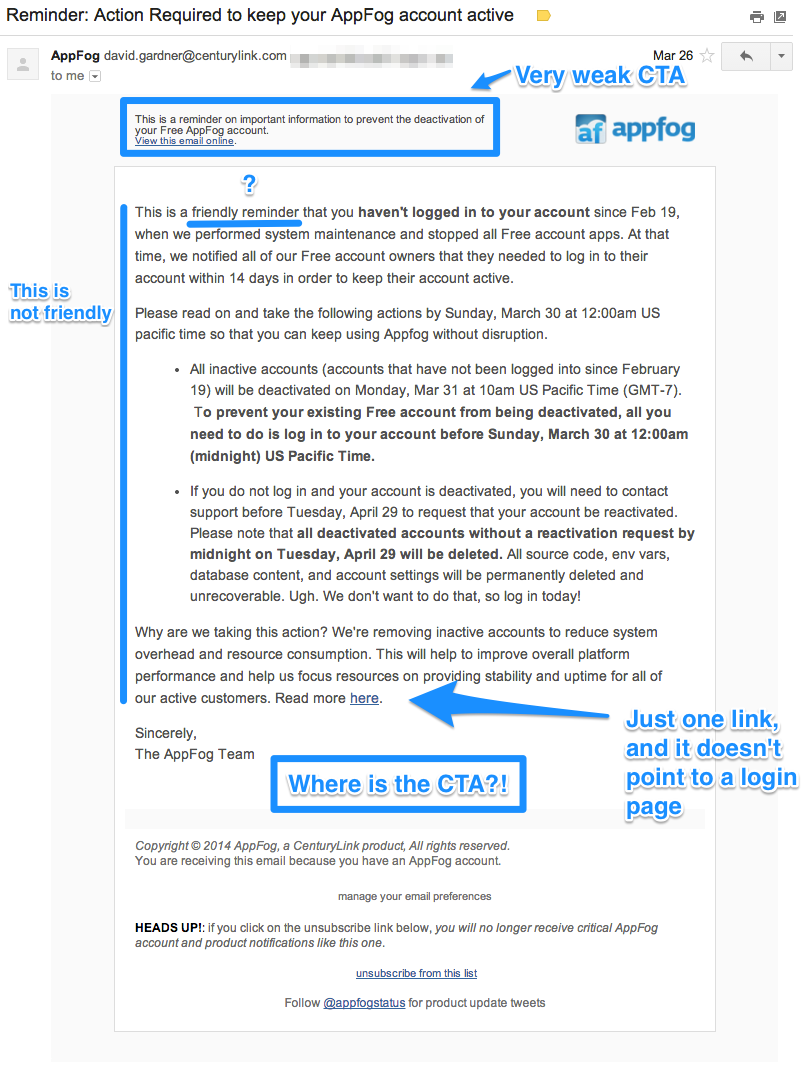
The first two emails were examples we should all strive to emulate but not every retention email is so effective. AppFog missed an important opportunity with this message. This email is different, however, because the stakes are higher. If I don’t login to my account, I lose it. Yet there isn’t a single link to a login page in this email!
Why This Email Needs Work
- Email marketers: You can’t tell users the email is friendly when in fact it’s not. This email is way too long and complicated. There are four different dates mentioned, multiple activation options and no clear call to action.
- This email could really benefit from a button. If you want people to login, make it as easy as possible. There isn’t even a link to login page, let alone a clear direction for the user to take.
- This email is frustrating in many ways but the biggest mistake is that it never reminds the user of the value of the their AppFog account. I used AppFog to make a sandbox for learning HTML and CSS. It has been enormously useful for me but nowhere in this email am I reminded of how this product can help me.
4. ProjectFlow
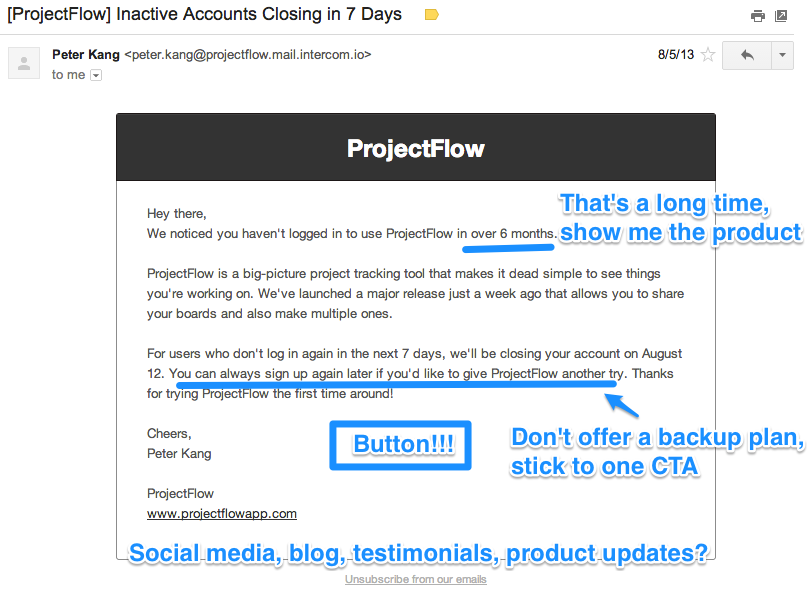
Why send an email without a call to action, especially when user engagement is so crucial to your business? ProjectFlow made similar mistakes to AppFog by sending a vague, forgettable email. If you want people to take action, make it dead simple.
Why This Email Needs Work
- As the email states, I haven’t logged into ProjectFlow in six months. At this point, I’ve completely forgotten what the product is and why I signed up in the first place. This email could really benefit from some some screenshots, a video demo and a testimonial. Without a reminder of the value of the product, I have no reason to consider using it.
- There is no clear call to action in this message. I understand they want me to login but there is no link or button to help me do it. This is one hundreds of emails I received that day. Since it doesn’t capture my attention and encourage me to take action, it’s forgotten.
-
One thing that retention emails should always avoid is a backup
plan. Don’t tell people they must login then offer an
alternative. Decide what action they should take and use the
entire email to emphasize it. It feels like they are saying
goodbye to me rather than welcoming me back:
For users who don’t log in again in the next 7 days, we’ll be closing your account on August 12. You can always sign up again later if you’d like to give ProjectFlow another try. Thanks for trying ProjectFlow the first time around!
- Links to social media channels, blogs and customer success stories aren’t backup plans, they are small steps towards a bigger goal. If the user isn’t ready or willing to login immediately, offer other ways for them to stay connected. Then, you can use those platforms to keep them moving in the right direction.
5. Weebly
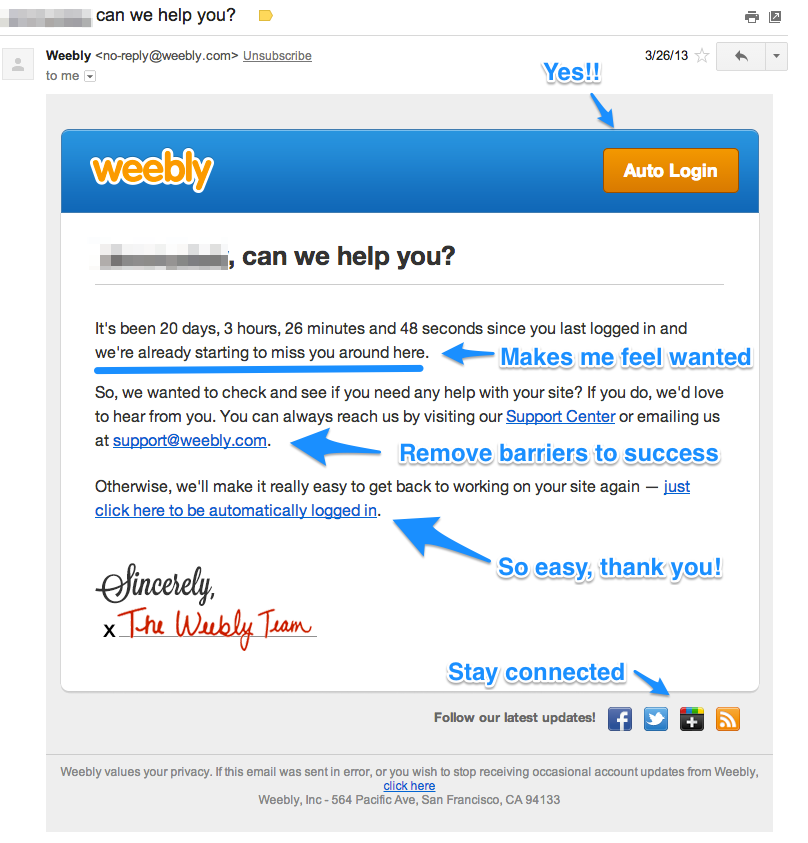
Let’s end this article on a positive note. Weebly killed it with this one.
Why This Email Rocks
- Weebly takes the customer support approach to this email. Not understanding how to use an app is one of the primary reasons users don’t login and use products, even if they like the software. Offering help is an easy and inviting way to get people engaged.
- Just like RunKeeper and Mint, Weebly makes me feel wanted by letting me know they miss me. Using words like “we” reminds users they aren’t alone. There is a community of people like them who wish they would come and participate.
- The “Auto Login” button and link are awesome. Thank you, Weebly, for making it easy to take action.
- The links to the social sites and blog are subtle but useful. Any opportunity to get users to follow you on other platforms is a good idea.
5 Tips for Killer Retention Emails
- Choose one call to action and use the entire email to emphasize it.
- Use buttons and deep links. Telling people to login without giving them an avenue to actually do it is a waste of time.
- Keep it concise. Use the copy to imply value, not convince people to take action. Don’t waste space and attention with words that don’t directly relate to your call to action.
- Avoid backup plans. Don’t tell you users “You must login or lose your account,” then say “But you could always make a new account later.” It’s confusing and will only distract users who might otherwise login.
- Create a sense of urgency. Giving users a timeframe to act can be a very powerful way to re-activate them. Don’t frame it as an ultimatum though, just use time as a tool to keep them moving.
Do you have any tips for killer retention emails? We’d love to hear them, just let us know in the comments.
Want to send more personalized mobile and email messages to your users?
Learn moreCustomer story

How Vero helps Plann cater to the needs of an agile startup that's scaling up quickly

